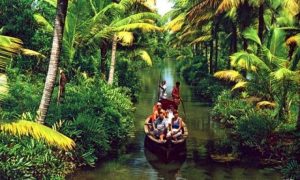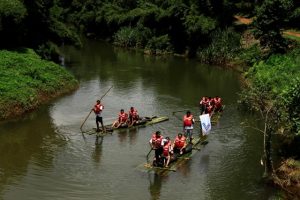Kerala secured first rank for the second year in a row in public affairs index (PAI) in governance among Indian States in 2017. The survey was based on 10 themes such as essential infrastructure, support to human development, social protection, women and children, crime, law and order, delivery of justice, environment, transparency and accountability, fiscal management and economic freedom. Kerala topped three categories: law and order, health and environment.
Kerala is Called ‘God’s own country’ because of the abundance of grandeur in this  state. Kerala is the only state in India which enjoys 100% literacy in India. It is one of the favorite states opted by millions of travelers in India. It is nestled between the pristine waters of the Arabian Sea on the west and the lush Western Ghat Mountains on the east, its intense network of rivers and lagoons, thick forests, exotic wildlife, serene stretches of emerald backwaters and a long shoreline of quiet beaches make it a traveler’s paradise. Besides, this state has maintained its rich cultural heritage. The literary meaning of Kerala is “the land of coconuts”. “Kera” in Malayalam (the language of Kerala) means coconut. As Kerala is abundant with coconut plants, it naturally got the name Kerala. In Kerala, you can find Coconut trees everywhere. The state has such wonderful and glorious attractions beyond one’s imagination.
state. Kerala is the only state in India which enjoys 100% literacy in India. It is one of the favorite states opted by millions of travelers in India. It is nestled between the pristine waters of the Arabian Sea on the west and the lush Western Ghat Mountains on the east, its intense network of rivers and lagoons, thick forests, exotic wildlife, serene stretches of emerald backwaters and a long shoreline of quiet beaches make it a traveler’s paradise. Besides, this state has maintained its rich cultural heritage. The literary meaning of Kerala is “the land of coconuts”. “Kera” in Malayalam (the language of Kerala) means coconut. As Kerala is abundant with coconut plants, it naturally got the name Kerala. In Kerala, you can find Coconut trees everywhere. The state has such wonderful and glorious attractions beyond one’s imagination.
Tourists get lost in the immaculate beauty of the place where three rivers meet, namely Kundalay, Mudrapuzha and Nallathanni. The lush green landscape, waterfalls, lakes, forests and tea plantations make this place a heaven on earth. The place offers spectacular view of misty valleys and lakes. Adventure sports such water sports, biking, paragliding, trekking, rock climbing and bamboo rafting, canoeing and kayaking is full of fun. Life in Kerala is the safest, healthiest, most environment-friendly and is ahead in both education and agriculture.
Treatment to Women: This is a state which has 1,085 women for every 1,000 men in human sex ratio. Majority of women in Kerala are more self dependant than those in other states. Almost all of them are educated and most of them are employed. No other state treats women equal to men as Kerala does. Kerala has long been the land where matriarchy which is followed among its influential communities and where women enjoyed property rights, and at times, the major share of it. Yes, this is the reality. Education among women has been a constant for nearly a century and at least 70 percent of them now have access to quality higher education. In all other parameters like health and employment too, the women in the state are way ahead. Kerala is also known as nursing hub. Women is Kearala opt for nursing as career because it has maximum opportunities abroad and pays really well. Nurses are in demand in Australia, Canada, Ireland and many gulf countries.
100% literacy: Its literacy rate is as high as 95%, says K.P Kannan, who was also former director at Center for Development Studies, a public policy think tank. Average schooling in Kerala is eight to nine years, against four in the rest of India, he says, and in the realm of demographic transition, it will take the rest of India at least 30 years to catch up with its average demographic statistics.
Sanitation: Kerala’s sanitation drive began much before Swacch Bharat became fashionable. Close to 95% of its households have toilets, as per 2011 census, while close to half of India doesn’t have them. In 2016, Kerala also claimed it had stopped open defecation. It is the third Indian state to do so after Sikkim and Himachal Pradesh.
High per capita income: According to K.P. Kannan, (whom I have mentioned above) as a noted scholar and economist on the state’s development, Kerala does not have the kind of indignity and poverty which marks several Indian states. Instead, he says, Kerala is often compared with developed countries, characterized by high literacy, incomes and expanded individual choices. The state has also one of the highest per-capita incomes among Indian states, aided by over Rs1 trillion that emigrant Keralites send in every year. There are several, nearly universal welfare measures such as highly subsidized, if not free, food grains, medical insurance, meals and uniforms in schools, and so on.
Famous for its welfare model: For long, Kerala’s welfare-oriented growth model has attracted attention, with economists like Amartya Sen, Jagdish Bhagwati and Arvind Panagariya weighing in on it in the past. Achievements such as low levels of infant mortality and population growth, and high levels of literacy and life expectancy, along with the factors responsible for such achievements have been considered characteristic results of the Kerala model. The state offers a set of high material quality-of-life indicators coinciding with low per-capita incomes, both distributed across nearly the entire population of Kerala. It practices a set of wealth and resource redistribution programes that have largely brought about the high material quality-of-life indicators. We see high levels of political participation and activism among ordinary people along with substantial numbers of dedicated leaders at all levels. Kerala’s mass activism and committed cadre were able to function within a largely democratic structure, which their activism has served to reinforce.
If you have not yet visited Kerala, take the first opportunity to visit this God’s Own Country!!!













































